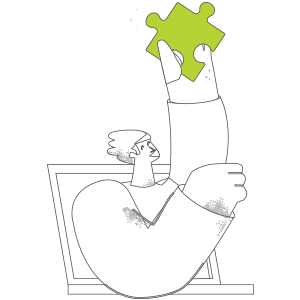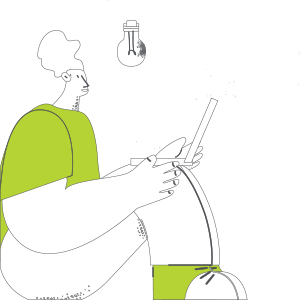As we all wrestle with hybrid ways of working, Instant's 2022 Predictions focus on how we can make this new approach to workspace strategy habitual.
If we have learned anything from the last two years it’s that the real estate industry is evolving at pace to meet new demands (as we anticipated in our 2021 Predictions). So, what can you do to plan ahead?
As we all wrestle with hybrid ways of working, our predictions this year focus on how we can make this new approach habitual.
So many of us have struggled with new routines, different locations and work pressure. What can we do to be effective and introduce purpose into our everyday work?
We have taken inspiration from the seminal model set out by Stephen R. Covey in his book The 7 Habits of Highly Effective People. We believe that the habits Covey highlights will help businesses remain agile and deliver the most effective and valuable approach to contemporary workspace.
Read below for our full 2022 Predictions, or download the report here.
1. BE PROACTIVE
In the war for talent... talent is winning.
Companies are testing new workplace strategies that put talent first. Developing an agile approach to space, underpinned by technology, is key as they “test and learn” their way to success.
- Agile spaces are increasingly being used as testbeds for new approaches to design and location, with demand for flexible space up 18% year on year. (1)
- 63% of businesses we have spoken to are already using technology to track utilization. (2)
- We expect 50% of companies to make further changes to their workplace strategy before the end of 2022.

2. BEGIN WITH THE END IN MIND
What is the workplace for?
Collaboration has been identified as the primary purpose for workspace… and design is changing to reflect that.
- We expect companies designing new offices to dramatically change the ratio of space usage.
- Dedicated desks are expected to make up less than 25% of workspaces in new offices by the end of the year.
- 83% of businesses we spoke to identified informal collaboration as one of the three most important types of space within their office going forward. (2)
- Just 46% identified dedicated workstations in the same way. (2)
- Design teams will work with HR and Real Estate to develop spaces from the ground up to enable collaboration.

3. PUT FIRST THINGS FIRST
Agility is the primary driver in workspace strategy…for now.
The ability to move quickly and efficiently is the #1 driver in future workspace strategy in 2022. Adoption of flexible workspace remains high compared to conventional office environments.
- In the UK coworking space occupancy sits at up to 80% (and is higher in some locations) compared to less than 40% in conventional office space. (3)
- Demand is being driven by a combination of start-up growth and investment in scale-up businesses.
- Requirements in regional cities and suburban locations continues to increase despite lockdowns abating.
"Work is moving from a noun to a verb, from a place we went to, to a thing we do irrespective of place." Joe Brady, CEO, Americas (The Instant Group)

4. THINK WIN-WIN
What is best for society as a whole is best for the workspace of the future.
In the midterm, sustainability will become the key driver of real estate activity, superseding previous considerations around head count and cost.
This is a win for ambitious net zero targets but also in providing staff with better working environments that focus heavily on wellness.
- 60% of Fortune 500 (4) and 66% of FTSE 100 (5) companies now have sustainability-based targets.
- By the end of 2023 sustainability will be a key focus for businesses and their workspace teams.

5. SEEK FIRST TO UNDERSTAND THEN BE UNDERSTOOD
Bridge the knowledge gap.
There is still a fundamental lack of real estate data from which to make evidence-based decision making. Only after companies can better understand usage, can they adapt their workplace strategies to take into account the new habits of the workforce.
- By the end of 2022, 30% of new buildings will be able to track and measure how space is used. But the absence of compelling data means that wholesale change to workplace strategy and delivery may well not be seen until 2023 at the earliest.
- There is a rise in a desire for workspace measurement above and beyond basic occupancy metrics.
- Sensor and anonymized cameras are increasingly becoming popular, with an array of new technologies on the horizon to enable the shift to hybrid working.
- 80% of corporate real estate firms do not have fully modernized core systems that can easily incorporate emerging technologies for the future, according to a Deloitte survey. (6)

6. SYNERGIZE
Can the office market pull together to deliver a better experience?
The silos that exist across the commercial real estate market make it extremely difficult for clients to optimise their workplace strategy. Even the most progressive occupier teams struggle to pull data and full market visibility across their portfolios.
- Just 27% of the companies we spoke to have data on how their employees are using space today, with 20% not even knowing if or when their staff are in the office itself. (2)
- With the office market facing the most significant challenge of its existence, now is the time for landlords, operators, service providers and occupiers to work together.
- Better synergies around data collation, reporting and analysis are required to enable an agile, hybrid approach to workspace strategy.
- This is particularly the case around sustainability and meeting net zero targets, where usage data is hard to reconcile across multiple sites.

7. SHARPEN THE SAW
Individuals are upskilled and willing to go it alone.
The last 18 months have allowed individuals to develop new opportunities or reassess their work life balance which has created an influx of entrepreneurial activity. This will create renewed growth of 18% for the flexible workspace industry by the end of 2022.
- We are living in a generation of ‘Millennipreneurs’ according to BNP Paribas. Young people have created twice as many businesses as baby boomers, with larger headcounts and higher target profits. (7)
- Business is booming - our survey of Companies House Data in the UK showed that new business start-ups are at the highest level for five years. (8)
- During the last year alone 4.4 million businesses were started in the US which is a 24% increase on the previous year’s figures. (9)
- And the flexible workspace industry is benefiting as those start-ups look at alternative locations to lower costs and pull in a more diverse talent pool.

If you have any questions about this report please email [email protected].
The data range of this report varies as follows:
- 2021 - this is based on data recorded up to 1st December 2021
- All other years mention are based on data recorded between 1st January - 31st December
- All data featured correct as of 1st December 2021
All other data referenced is as follows:
- 1. IO website traffic, first 3 quarters of 21 compared to first 3 quarters of 2020
- 2. The Instant Group Agile CRE Think Tank Round three interviews
- 3. The Instant Group - Large flexible workspaces are in short supply as more corporate clients put value on agility
- 4. WWF - Fortune 500 companies are acting on the climate crisis but is it enough
- 5. Proactive Investors - Only 19 companies in FTSE 100 on track to reach net-zero goals despite pledges
- 6. Deloitte Commercial Real Estate Outlook
- 7. BNP Paribas Global Entrepreneur Report
- 8. Instant Offices - Most Entrepreneurial City in the UK 2021
- 9. Peterson Institute for international economics study



